Fowler A. Mathematical Geoscience
Подождите немного. Документ загружается.


680 10 Glaciers and Ice Sheets
Fig. 10.11 A multivalued
flux–depth relation can cause
oscillatory surges
10.4.2 Surges
It has long been suggested that the fast velocities during surges could only be caused
by rapid sliding. Therefore it is sufficient for our purpose to analyse the mass con-
servation equation in the form
H
t
+(H u)
x
=B
(x), (10.323)
where u is the sliding velocity. Also, it has been thought that if the sliding velocity
were a multivalued function of basal stress τ
b
(i.e., τ
b
(u) has a decreasing portion)
then, since τ
b
= H(1 − μs
x
) ≈ H , this would cause the ice flux Q = uH to be
multivalued, as shown in Fig. 10.11. In this case we might expect relaxation oscil-
lations to occur for values of B intermediate between the two noses of Q(H ).Two
fundamental questions arise. Firstly, is there any genuine reason why τ
b
(u) should
be non-monotone, and secondly, how would such a relaxation oscillator work in the
spatially dependent case? In particular, it would seem necessary to have a secondary
variable, whose rapid change can facilitate the relaxation between the different so-
lution branches (cf. Fig. 1.6 and Eqs. (1.25)).
The discussion in Sect. 10.2 suggested the possibility of non-monotone τ
b
(u) for
flow over a periodic bed. However, it is arguable whether real beds have this fea-
ture,
21
in which case we may suppose that τ increases with both u and N . What
observations of the 1982–3 surge of Variegated Glacier showed, however, was that
there is a switch in drainage pattern during its surge. There are (at least) two pos-
sible modes of drainage below a glacier. Röthlisberger channels, as described in
Sect. 10.2, can form a branched arterial drainage system. In this case the value of
the effective pressure at the bed N is determined by the water flow, N = N
R
,say.
Alternatively, there may be no channel system, and the water at the bed fills the
cavities behind bed protuberances, and drains by a slower leakage between cavities.
This is the linked cavity régime described in Sect. 10.3.2; it operates at a higher
water pressure and thus lower effective pressure, N
c
, than in the channel drainage.
21
An exception may be the very steep ‘hanging glaciers’, where the periodic behaviour consists of
complete detachment of the glacier snout following tensile fracture.
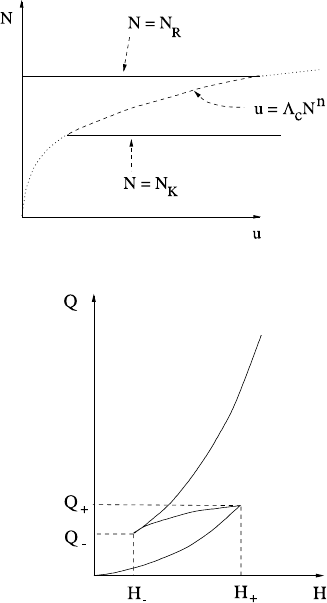
10.4 Waves, Surges and Mega-surges 681
Fig. 10.12 N is a
multivalued function of u
Fig. 10.13 Q is a
multivalued function of H
The crucial factor which enables surges to take place is the switching mechanism,
and this depends on the ice flow over the cavities.
We now combine the form of the sliding law τ
b
= Nf (u/N
n
), as discussed in
Sect. 10.2, with a drainage system consisting either of Röthlisberger channels or
linked cavities, the choice of which depends on the value of Λ = u/N
n
, with the
transition between drainage systems occurring at the critical value Λ
c
. That is,
N =N
R
,u/N
n
<Λ
c
;
N =N
c
,u/N
n
>Λ
c
.
(10.324)
If this is written as a function N(u), it is multivalued, as shown in Fig. 10.12.Asa
consequence of this, the sliding law is indeed multivalued, and hence Q(H) has the
form shown in Fig. 10.13.
There are two critical values of Q in Fig. 10.13, denoted Q
+
,Q
−
: these are the
values at the noses of the curve (where also H = H
+
,H
−
). If B(x) < Q
+
, then
an equilibrium glacier profile exists in which Q =B(x). However, if the maximum
value of B, B
max
, is greater than Q
+
, then such a stable equilibrium cannot occur,
and the glacier surges.

682 10 Glaciers and Ice Sheets
The sequence of events in a surge is then as follows. The glacier grows from a
quiescent state in which Q<Q
+
on the lower (slow) branch everywhere. When
the maximum depth reaches H
+
, there is a reservoir zone where H>H
−
.The
ice flux at H
+
jumps to the upper (fast) branch by switching drainage pattern, and
this switch propagates upstream and downstream to where H = H
−
. These activa-
tion waves propagate at rates of hundreds of metres per hour (and in effect have
been observed). Once the activation waves have propagated to the boundaries of
the reservoir zone, the ice flow is described by the fast mode on the upper branch,
and the activated reservoir zone propagates rapidly downstream, possibly overrid-
ing the stagnant snout and propagating forwards as a front. In terms of Fig. 10.13,
the surge terminates when H reaches H
−
everywhere, and deactivation waves prop-
agate inwards from the boundaries of the exhausted reservoir zone to re-establish
the channel drainage system. There then follows another quiescent phase where the
maximum value of H increases from H
−
to H
+
before the next surge is initiated.
10.4.3 Sliding and Ice Streams
It is not known for certain why the ice flow on the Siple Coast of Antarctica, which
flows out to the floating Ross ice shelf, segregates itself into the five distinct ice
streams A to E. The picture which one has of this region is of a gently sloping
(slope α ∼10
−3
) kilometer thick ice sheet which flows in the ice streams at typical
ratesof500my
−1
. Such rapid velocity can only be due to basal sliding, and the
seismic evidence indicates that the ice is underlain by several metres of wet till. One
might expect that a sliding law of the form advocated previously is appropriate, that
is,
τ
b
=cu
r
b
N
s
, (10.325)
with r and s positive. The issue then arises as to how to prescribe N. Recall from
Sect. 10.2 that for drainage through Röthlisberger channels, an appropriate law is
N =βQ
1/4n
w
, where Q
w
is water flux. When ice flows over till, an alternative system
of drainage is that of distributed ‘canals’ incised in the subglacial till. For such a
system, an appropriate law is N =γQ
−1/n
w
, and the low values of effective pressure
in this relation are more representative of measured basal pressures on Whillans ice
stream, for example.
In this case an interesting feedback exists. In Antarctic ice streams, there is little,
if any, surface melt reaching the bed, and the basal water flow is due to melting
there. The quantity of meltwater produced per unit area per unit time is given by the
melt velocity
v
m
=
G +τ
b
u
b
−g
ρ
w
L
, (10.326)
where ρ
w
is water density, L is latent heat, G is geothermal heat flux, and g is the
basal heat flux into the ice. This assumes the base is at the melting point. Thus we

10.4 Waves, Surges and Mega-surges 683
expect the basal water flux Q
w
∝G +τ
b
u
b
−g, and so Q
w
increases with u
b
(the
dependence of g on u
b
is likely to be weaker—boundary layer theory would suggest
g ∼ u
1/2
b
). If also N decreases with Q
w
, then N decreases as u
b
increases. But this
causes further increase of u
b
via the sliding law. This positive feedback can lead to
a runaway phenomenon which we may call hydraulic runaway.
To get a crude idea of how this works, we denote the ice thickness as h and the
surface slope as S
i
. If the velocity is u, then the ice flux per unit width is
Q =hu; (10.327)
the basal shear stress is
τ =Rh =cu
r
N
s
, (10.328)
where we define
R =ρ
i
gS
i
; (10.329)
we suppose
N =γQ
−p
w
, (10.330)
and that
Q
w
=b[G +τu−g], (10.331)
where, from (10.326), we define
b =
l
i
l
s
ρ
w
L
, (10.332)
in which l
i
is the ice flow line length scale and l
s
is the stream spacing, and the heat
flux to the ice is given by
g =au
1/2
, (10.333)
corresponding to a heat flux through a thermal boundary layer. Consequently
h =
fu
r
[G +Rhu −au
1/2
]
m
, (10.334)
where
m =ps, f =
cγ
s
Rb
m
. (10.335)
It is not difficult to see from (10.334), if f is low enough (equivalently, the fric-
tion coefficient c is low enough), that u and hence the ice flux Q will be a multival-
ued function of h, as shown in Fig. 10.14. In fact, application of realistic parameter
values suggests that such multivalued flux laws are normal. More specifically, we
choose estimates for the parameters as follows. We use exponents p = r = s =
1
3
and thus m =
1
9
, and then c = 0.017 bar
2/3
m
−1/3
y
1/3
, based on a sliding law
(10.328) with τ =0.1 bar, N =0.4 bar and u =500 m y
−1
. Other parameter values
are γ =0.3 bar (m
3
s
−1
)
1/3
, S
i
=10
−3
, ρ
i
=0.917 × 10
3
kg m
−3
, g = 9.8ms
−2
,
G = 0.06 W m
−2
, ρ
w
= 10
3
kg m
−3
, L = 3.3 × 10
5
Jkg
−1
, and in addition we
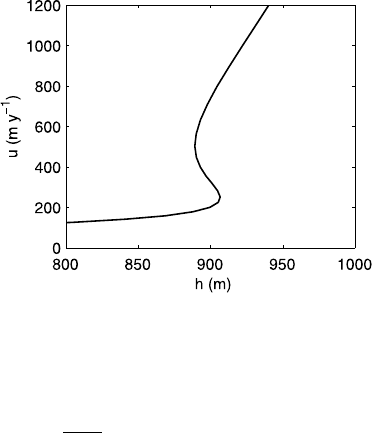
684 10 Glaciers and Ice Sheets
Fig. 10.14 Thermal feedback
causes a multivalued ice flux.
The solution of (10.334)is
plotted using a value of the
critical parameter
f = 70 W
1/9
m
4/9
y
1/3
.
Other values are as described
in the text. I am indebted to
Ian Hewitt for his production
of this figure
choose l
i
= 10
3
km, l
s
= 330 m; from these we find R = 3 × 10
−7
Wm
−4
y,
b = 1J
−1
m
5
, and thus f = 126 W
1/9
m
4/9
y
1/3
. Finally, we choose the value of
a based on an assumed magnitude of g ≈
4kT
d
i
, where ice depth is d
i
= 10
3
m,
thermal conductivity is k = 2.2Wm
−1
K
−1
, and surface temperature below freez-
ing is T =20 K; with u = 500 m y
−1
, this gives a = 0.8 ×10
−2
Wm
−5/2
y
1/2
.
Figure 10.14 plots velocity versus depth with these parameter values, except that
we take f =70 W
1/9
m
4/9
y
1/3
, and Question 10.14 provides approximate analytic
solutions for the different branches.
If, indeed, hydraulic feedback can cause a multivalued relationship between ice
velocity and depth, what then happens in a region such as the Siple Coast of West
Antarctica? We suppose that the ice flux is determined by conditions upstream, so
that if the ice flux per unit width is q, and the width of the discharge region is W ,
then
Wq =B, (10.336)
where B is the volume flux of ice discharged. If the flow law is multivalued,
then there exists a range (q
−
,q
+
) of q such that the ice flow is unstable (see
Question 10.14). If B/W < q
−
, then a uniform slow moving ice flow is possi-
ble. Similarly, if B/W > q
+
, a uniform fast-moving ice stream is possible. What
if q
−
<B/W <q
+
? A uniform ice flow is now unstable, and we may expect a
spatial instability to occur, whereby ice streams spontaneously form, as is in fact
observed. Such an instability would be mediated by transitions in water pressure,
since basal water will flow from fast streams at high water pressure to slower ice at
low water pressure. This generates a lateral enthalpy flux, and in a steady state this
can be balanced by a heat flux in the ice in the opposite direction, since cooling (g)
is less effective at lower u, therefore the slow ice is warmer near the base than the
ice streams.
10.4 Waves, Surges and Mega-surges 685
10.4.4 Heinrich Events and the Hudson Strait Mega-surge
What if the drainage channel of an ice sheet over deforming till is relatively narrow?
By analogy with the pattern formation mechanism in reaction–diffusion equations,
one would expect that a multivalued flux–depth relation would not allow separate
streams to form if the channel width is too small, and in this case we would expect
periodic surges to occur down the channel, if the prescribed mass flux corresponds
to a velocity on the unstable position of Fig. 10.14.
A situation of this type appears to have occurred during the last ice age. The Lau-
rentide ice sheet which existed in North America drained the ice dome which lay
over Hudson Bay out through the Hudson Strait, a 200 km wide trough which dis-
charged the ice (as icebergs) into the Labrador sea and thence to the North Atlantic.
Hudson Bay is underlain by soft carbonate rocks, mudstones, which can be mo-
bilised when wet. It has been suggested that the presence of these deformable sed-
iments, together with the confined drainage channel, led to the occurrence of semi-
periodic surges of the Hudson Strait ice stream. The evolution of events is then as
follows. When ice is thin over Hudson Bay, the mudstones may be frozen at the base,
there is little, if any, sliding and very little ice flow. Consequently, the ice thickens
and eventually the basal ice warms. The basal muds thaw, and sliding is initiated.
If the friction is sufficiently low (i.e., c and thus f is small), then the multivalued
sliding law of Fig. 10.14 is appropriate, and if the accumulation rate is large enough,
cyclic surging will occur. During a surge, the flow velocity increases dramatically,
and there results a massive iceberg flux into the North Atlantic. On the lower branch
of Fig. 10.14, water production is virtually absent, Q
w
is low in (10.331) since the
flow is slow and the geothermal and viscous heat at the base can be conducted away
by the ice. The low value of Q
w
gives high N , consistent with low u. On the upper
branch, however, viscous heat dominates, and Q
w
is large, N is small, also consis-
tent with a high u.
At the end of a surge, the rapid ice drawdown causes the water production to
drop, and the rapid velocities switch off. This may be associated with re-freezing of
the basal mudstones.
When water saturated soils freeze, frost heave occurs by sucking up water to the
freezing front via capillary action, and this excess water freezes (at least for fine
grained clays and silts) in a sequence of discrete ice lenses. Heaving can occur at
a typical rate of perhaps a metre per year, though less for fine grained soils, and
the rate of heave is suppressed by large surface loads. Calculations suggest a surge
period of perhaps a hundred years, with a drawdown of a thousand metres, and a
recovery period on the order of 5,000–10,000 years. During the surge, the rapidly
deforming basal muds will dilate (in the deforming horizon, likely to be only a metre
or so thick). At the termination of a surge, this layer re-consolidates, and we can
expect the total heave to be a certain (small) fraction of the frost penetration depth.
In effect, the ice lenses freeze the muds into the ice stream, so that when the next
surge phase is initiated, some of this frozen-in basal sediment will be transported
downstream, and thence rafted out into the North Atlantic in iceberg discharge.

686 10 Glaciers and Ice Sheets
As discussed in Chap. 2, there is evidence that this rather glamorous sequence
of events actually occurs. Heinrich events are layers of ice-rafted debris in deep-
sea sediment cores from the North Atlantic which indicate (or are consistent with)
massive iceberg discharges every 7000 years or so. In addition, oxygen isotope con-
centrations in ice cores from Greenland indicate that severe cooling cycles occurred
during the last ice age. These cooling events may be caused by a switch-off of North
Atlantic deep water (NADW) circulation—effectively switching off the convective
heat transport from equatorial latitudes and thus cooling the atmosphere. It seems
that sequences of these cooling cycles are terminated by Heinrich events, in the
sense that following Heinrich events the climate warms dramatically, perhaps after
some delay. There are two reasons why this should be so. On the one hand, the
sudden reduction in ice thickness should warm the air above, and also it can be ex-
pected that a massive iceberg (and thus freshwater) flux to the North Atlantic acts
as a source of thermal buoyancy, which first slows down and subsequently restarts
a vigorous North Atlantic circulation. Rather than being lumbering beasts, glaciers
and ice sheets show every sign of being dynamically active agents in shaping the
climate and the earth’s topography.
10.5 Drumlins and Eskers
There are a number of bedforms associated with the motion of ice sheets, and in this
section we will discuss two of them, drumlins and eskers. Drumlins are small hills,
22
generally of oval shape, which corrugate the landscape, as shown in Figs. 10.15
and 10.16. They are formed ubiquitously under ice sheets, and take a range of
shapes, depending presumably on the basal ice conditions. Ribbed moraines, also
called Rogen moraines after the area in Sweden (Lake Rogen) where such features
were first described, are transverse furrows like a washboard, with the undulations
(presumed) perpendicular to the former ice flow. They are analogous to the trans-
verse dunes described in Chap. 5, and as we shall see, are supposed to be formed by
an analogous instability mechanism.
The three-dimensional drumlins of Fig. 10.15 may then arise through a secondary
transverse instability, perhaps as some parameter associated with ice flow changes.
What certainly happens under former fast-moving ice streams is that drumlins be-
come elongated in the direction of ice flow, appearing eventually to become ex-
tremely long grooves aligned with the flow. These grooves, which can run for hun-
dreds of kilometres, are called mega-scale glacial lineations (MSGL), and give the
landscape the appearance of having been combed. Figure 10.17 shows a system of
MSGL in Northern Canada.
Eskers
23
are sinuous ridges of gravel and sand, of similar dimensions to drum-
lins, having elevations of tens of metres. They are associated with former drainage
22
The word ‘drumlin’ is of Irish origin, generally thought to be a diminutive of the word druim,
meaning a hill, and thus a drumlin is a ‘small hill’.
23
The term esker is also Irish, from eiscir, meaning a small ridge.
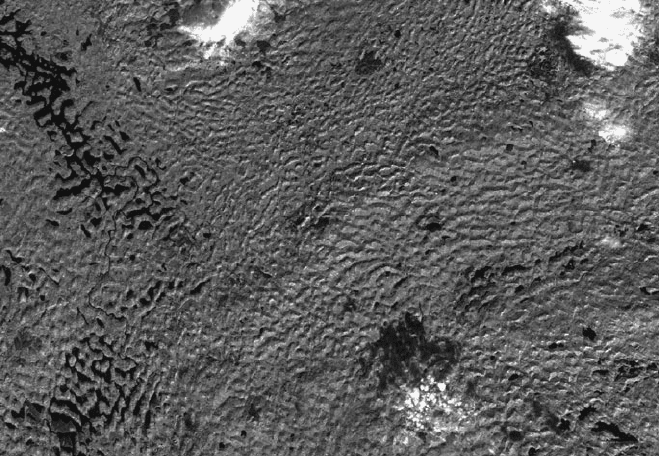
10.5 Drumlins and Eskers 687
Fig. 10.15 Drumlins in Northern Ireland. Satellite view
channels under the ice, most probably Röthlisberger channels, which have become
infilled with subglacial sediment. Figure 10.18 shows a satellite view of an esker
system in Northern Canada. The eskers are the red lineations, and their disordered
and nonlinear arrangement suggests that they may have been formed at different
times, as the ice flow changes direction.
10.5.1 Drumlins
We build a theory of drumlin formation by analogy with the theory of dune forma-
tion. An ice sheet flows as indicated in Fig. 10.19 over a deformable substrate at
z = s, where s is the elevation of the bedrock. The ice at the base is at the melt-
ing point, and there is a local drainage system for the resulting meltwater. How we
treat this drainage system is key. To begin with, we suppose that the drainage sys-
tem organises itself as described earlier, independently of the evolution of the bed
elevation.
The surface elevation of the ice sheet is z =z
i
, relative to a level z =0 located at
the elevation of the local drainage system. We suppose the bed consists of a saturated
till of porosity φ. If the pore water pressure at the interface z = s is p
s
w
and the
overburden normal stress there is P
s
, then the corresponding pore and overburden
pressures below the surface are taken to be
p
w
=p
s
w
+ρ
w
g(s −z), P =P
s
+
ρ
w
φ +ρ
s
(1 −φ)
g(s −z), (10.337)
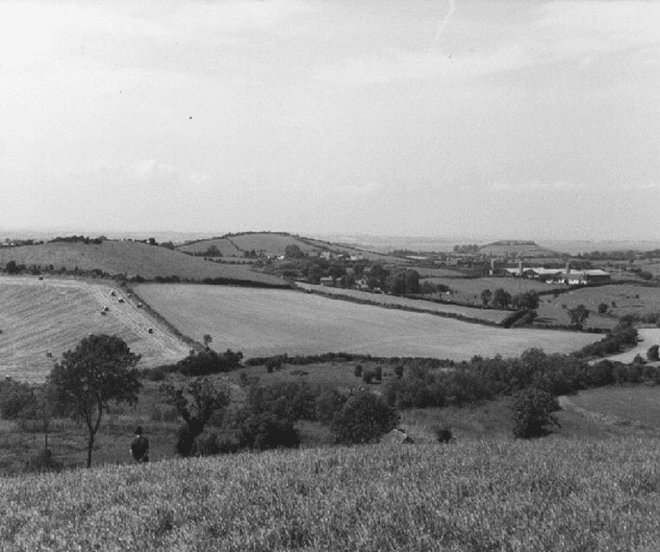
688 10 Glaciers and Ice Sheets
Fig. 10.16 Drumlins in the Ards Peninsula of Northern Ireland
simply through hydrostatic and lithostatic balance: ρ
w
and ρ
s
are the densities of
water and sediment, respectively. Within the till, the effective pressure is defined as
p
e
=P −p
w
, (10.338)
and thus
p
e
=N +(1 −φ)ρ
sw
g(s −z), (10.339)
where
ρ
sw
=ρ
s
−ρ
w
, (10.340)
and N is the effective pressure at the interface,
N =P
s
−p
s
w
. (10.341)
The interfacial normal stress P
s
is related to the stress in the ice by
P
s
=−σ
nn
=p
s
i
−τ
nn
, (10.342)
where σ
nn
is the normal stress in the ice, τ
nn
is the deviatoric normal stress in the
ice, and p
s
i
is the ice pressure at the bed. As is customary in ice sheet dynamics, we
define the reduced pressure Π in the ice by
p
i
=p
a
+ρ
i
g(z
i
−z) +Π, (10.343)
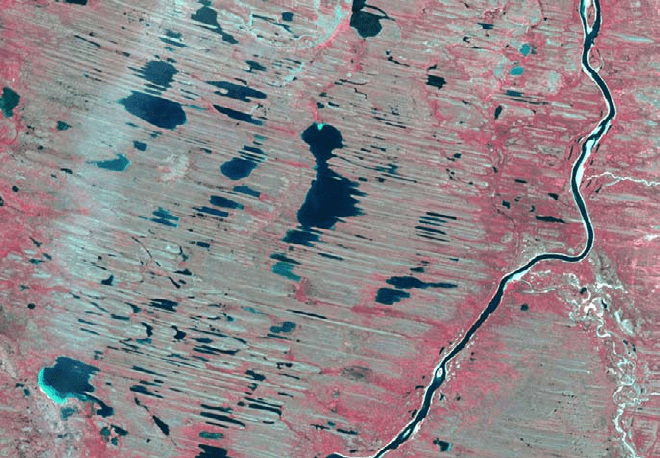
10.5 Drumlins and Eskers 689
Fig. 10.17 Satellite view of MSGL in Northern Canada. The lineations are about a hundred metres
in width, and of the order of a hundred kilometres in length
where p
a
is atmospheric pressure, and we define the effective pressure in the
drainage system as
N
c
=p
a
+ρ
i
gz
i
−p
c
, (10.344)
where p
c
is the water pressure in the local drainage system, which we presume
known. From these it follows that the effective pressure at the bed is given by
N =N
c
+ρ
wi
gs +Π −τ
nn
, (10.345)
where
ρ
wi
=ρ
w
−ρ
i
. (10.346)
The drainage effective pressure N
c
is presumed to be determined by the properties
of the local hydraulic drainage system, as discussed in Sect. 10.3.
Bed Evolution
We restrict our initial presentation of the model to two dimensions (x, z),forthe
sake of clarity. The generalisation to three dimensions is given subsequently (see
also Question 10.16). The evolution of the bed is given by the Exner equation
s
t
+q
x
=0, (10.347)
